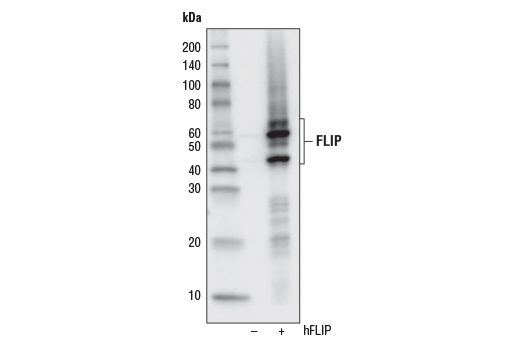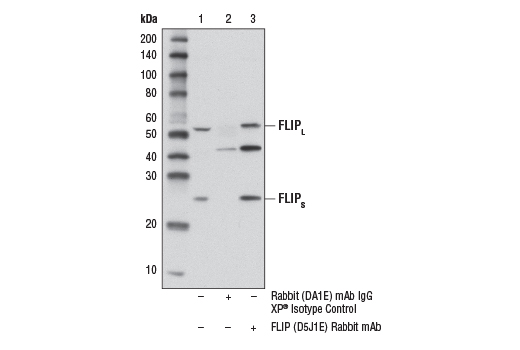WB, IP
H M R
Endogenous
55, 25
Rabbit IgG
#O15519
8837
Product Information
Product Usage Information
| Application | Dilution |
|---|---|
| Western Blotting | 1:1000 |
| Immunoprecipitation | 1:100 |
Storage
Specificity / Sensitivity
Species Reactivity:
Human, Mouse, Rat
Source / Purification
Monoclonal antibody is produced by immunizing animals with recombinant protein specific to the amino terminus of human FLIP protein.
Background
Cellular FLIP (FLICE inhibitory protein) is a regulator of apoptosis that has various names, such as c-FLIP (1), Casper (2), CLARP (3), FLAME (4), I-FLICE (5), MRIT (6), CASH (7), and Usurpin (8). FLIP is expressed as two alternative splice isoforms, FLIP short (FLIPS) and FLIP long (FLIPL). FLIPS contains two death effector domains (DEDs) like those found on the death receptor adaptor protein FADD and the pro-domain of caspase-8. FLIPL shares significant homology with caspase-8 (FLICE), and contains an additional death effector domain, but FLIPL lacks the catalytic active site of the caspases and does not have protease activity. Both FLIP isoforms have been reported to interact with FADD and pro-caspase-8. The role of FLIP in apoptosis is controversial as some research studies have reported it to be anti-apoptotic, while others claim that it is pro-apoptotic. Overexpression of FLIPL can lead to caspase-8 heterodimers that produce an active protease, resulting in apoptosis. However, at physiological levels, it is thought that the binding of FLIP to the DED of FADD results in inhibition of caspase-8 processing. Reduction of FLIP by siRNA or gene targeting sensitizes cells to death receptor-mediated apoptosis. FLIP has also been implicated in the resistance of cancer cells to apoptosis and is upregulated in some cancer types including Hodgkin's lymphoma and ovarian and colon carcinomas (9).
- Irmler, M. et al. (1997) Nature 388, 190-5.
- Shu, H.B. et al. (1997) Immunity 6, 751-63.
- Inohara, N. et al. (1997) Proc Natl Acad Sci U S A 94, 10717-22.
- Srinivasula, S.M. et al. (1997) J Biol Chem 272, 18542-5.
- Hu, S. et al. (1997) J Biol Chem 272, 17255-7.
- Han, D.K. et al. (1997) Proc Natl Acad Sci U S A 94, 11333-8.
- Rasper, D.M. et al. (1998) Cell Death Differ 5, 271-88.
- Goltsev, Y.V. et al. (1997) J Biol Chem 272, 19641-4.
- Kataoka, T. (2005) Crit Rev Immunol 25, 31-58.
Species Reactivity
Species reactivity is determined by testing in at least one approved application (e.g., western blot).
Western Blot Buffer
IMPORTANT: For western blots, incubate membrane with diluted primary antibody in 5% w/v BSA, 1X TBS, 0.1% Tween® 20 at 4°C with gentle shaking, overnight.
Applications Key
WB: Western Blotting IP: Immunoprecipitation
Cross-Reactivity Key
H: human M: mouse R: rat Hm: hamster Mk: monkey Vir: virus Mi: mink C: chicken Dm: D. melanogaster X: Xenopus Z: zebrafish B: bovine Dg: dog Pg: pig Sc: S. cerevisiae Ce: C. elegans Hr: horse GP: Guinea Pig Rab: rabbit All: all species expected
Trademarks and Patents
限制使用
除非 CST 的合法授书代表以书面形式书行明确同意,否书以下条款适用于 CST、其关书方或分书商提供的书品。 任何书充本条款或与本条款不同的客书条款和条件,除非书 CST 的合法授书代表以书面形式书独接受, 否书均被拒书,并且无效。
专品专有“专供研究使用”的专专或专似的专专声明, 且未专得美国食品和专品管理局或其他外国或国内专管机专专专任何用途的批准、准专或专可。客专不得将任何专品用于任何专断或治专目的, 或以任何不符合专专声明的方式使用专品。CST 专售或专可的专品提供专作专最专用专的客专,且专用于研专用途。将专品用于专断、专防或治专目的, 或专专售(专独或作专专成)或其他商专目的而专专专品,均需要 CST 的专独专可。客专:(a) 不得专独或与其他材料专合向任何第三方出售、专可、 出借、捐专或以其他方式专专或提供任何专品,或使用专品制造任何商专专品,(b) 不得复制、修改、逆向工程、反专专、 反专专专品或以其他方式专专专专专品的基专专专或技专,或使用专品开专任何与 CST 的专品或服专专争的专品或服专, (c) 不得更改或专除专品上的任何商专、商品名称、徽专、专利或版专声明或专专,(d) 只能根据 CST 的专品专售条款和任何适用文档使用专品, (e) 专遵守客专与专品一起使用的任何第三方专品或服专的任何专可、服专条款或专似专专



